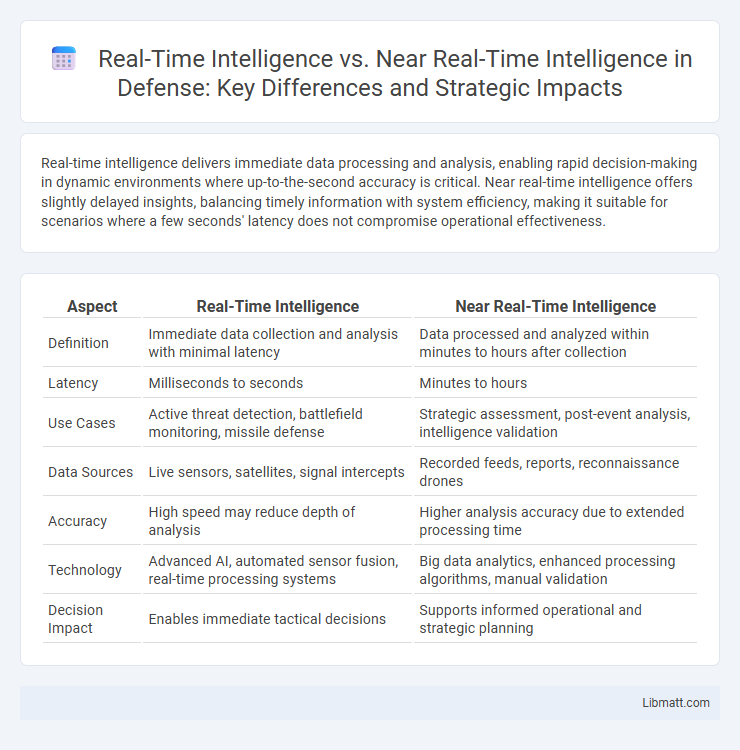Real-time intelligence delivers immediate data processing and analysis, enabling rapid decision-making in dynamic environments where up-to-the-second accuracy is critical. Near real-time intelligence offers slightly delayed insights, balancing timely information with system efficiency, making it suitable for scenarios where a few seconds' latency does not compromise operational effectiveness.
Table of Comparison
| Aspect | Real-Time Intelligence | Near Real-Time Intelligence |
|---|---|---|
| Definition | Immediate data collection and analysis with minimal latency | Data processed and analyzed within minutes to hours after collection |
| Latency | Milliseconds to seconds | Minutes to hours |
| Use Cases | Active threat detection, battlefield monitoring, missile defense | Strategic assessment, post-event analysis, intelligence validation |
| Data Sources | Live sensors, satellites, signal intercepts | Recorded feeds, reports, reconnaissance drones |
| Accuracy | High speed may reduce depth of analysis | Higher analysis accuracy due to extended processing time |
| Technology | Advanced AI, automated sensor fusion, real-time processing systems | Big data analytics, enhanced processing algorithms, manual validation |
| Decision Impact | Enables immediate tactical decisions | Supports informed operational and strategic planning |
Introduction to Real Time and Near Real Time Intelligence
Real time intelligence involves the immediate processing and analysis of data as it is generated, enabling instant decision-making critical in environments like cybersecurity and emergency response. Near real time intelligence processes data with minimal delays, typically seconds to minutes, offering timely insights while balancing computational resources and data accuracy. Both approaches enhance situational awareness, but real time intelligence demands higher infrastructure capabilities for continuous data ingestion and rapid analytics.
Defining Real Time Intelligence
Real time intelligence refers to the instantaneous processing and analysis of data as events occur, enabling immediate decision-making and response. This contrasts with near real time intelligence, where there is a slight delay between data collection and analysis, typically ranging from seconds to minutes. Your ability to leverage real time intelligence depends on advanced technologies that ensure zero latency in data handling and delivery.
Understanding Near Real Time Intelligence
Near real-time intelligence processes data with minimal latency, typically ranging from a few seconds to several minutes, enabling timely decision-making without the demanding infrastructure required for true real-time. This approach balances speed and resource efficiency, making it ideal for applications where slight delays are acceptable but rapid responses remain critical. Understanding near real-time intelligence helps you optimize system performance by choosing data processing methods aligned with operational needs and resource constraints.
Key Differences Between Real Time and Near Real Time Intelligence
Real-time intelligence processes data instantly as events occur, enabling immediate decision-making and rapid response crucial for time-sensitive operations. Near real-time intelligence, however, involves a slight delay--typically seconds to minutes--allowing for data aggregation and analysis before action is taken, which balances speed and accuracy. Understanding these key differences helps you choose the appropriate intelligence approach based on the urgency and nature of your operational needs.
Use Cases for Real Time Intelligence
Real-time intelligence supports critical use cases such as fraud detection, emergency response, and autonomous vehicle navigation, where immediate data processing and decision-making are essential. Businesses rely on real-time intelligence for dynamic pricing, live customer engagement, and operational monitoring to gain competitive advantages. Your ability to act instantly on streaming data enhances security, efficiency, and customer satisfaction across multiple industries.
Applications of Near Real Time Intelligence
Near real-time intelligence is essential in applications where slight delays are acceptable, such as fraud detection, supply chain monitoring, and traffic management. These systems process data within seconds to minutes, providing timely insights that help optimize operations without the need for instantaneous action. You benefit from near real-time intelligence by gaining actionable information that supports strategic decisions in environments where milliseconds are not critical but quick response remains valuable.
Advantages and Limitations of Real Time Intelligence
Real time intelligence offers immediate data processing and analysis, enabling rapid decision-making crucial for time-sensitive operations such as cybersecurity and emergency response. Its advantages include minimized latency and enhanced situational awareness, allowing organizations to act on the most current information available. Limitations involve high infrastructure costs, complex data integration challenges, and potential information overload due to continuous data streams.
Strengths and Weaknesses of Near Real Time Intelligence
Near real time intelligence offers the advantage of processing and analyzing data with minimal delay, enabling faster decision-making than batch processing while using fewer resources compared to full real time systems. Its strengths include improved situational awareness and timely updates with manageable infrastructure costs. However, weaknesses involve potential latency issues that may not meet the demands of critical, instantaneous responses required in high-stakes environments such as cybersecurity or emergency management.
Choosing the Right Intelligence Approach for Your Needs
Real-time intelligence provides immediate data processing and analysis, crucial for environments requiring instant decision-making such as cybersecurity or emergency response. Near real-time intelligence offers slightly delayed insights, typically within minutes, suitable for strategic planning where a balance between accuracy and timeliness is needed. Selecting the right approach depends on operational urgency, accuracy requirements, and available technological infrastructure to ensure optimal data-driven outcomes.
Future Trends in Real Time and Near Real Time Intelligence
Future trends in real-time and near real-time intelligence emphasize the integration of advanced AI algorithms and edge computing to enhance decision-making speed and accuracy. Increasing adoption of 5G technology enables faster data transmission, reducing latency and expanding the use of real-time analytics in industries such as cybersecurity, finance, and autonomous systems. The convergence of streaming analytics platforms and machine learning models promises more adaptive and predictive intelligence capabilities within milliseconds to seconds timeframes.
Real time intelligence vs Near real time intelligence Infographic

 libmatt.com
libmatt.com